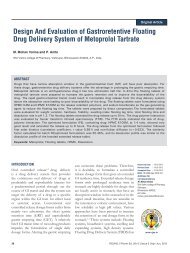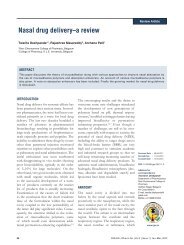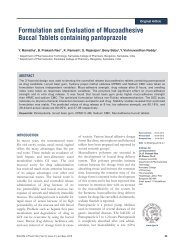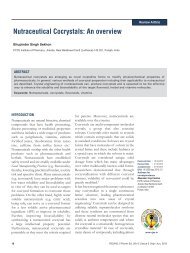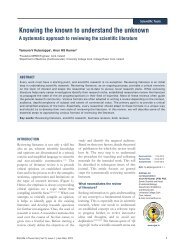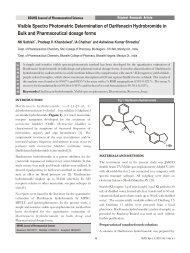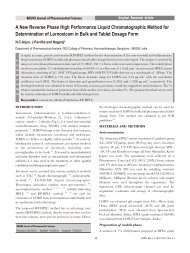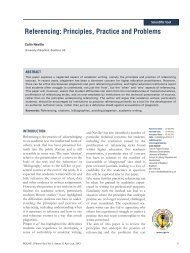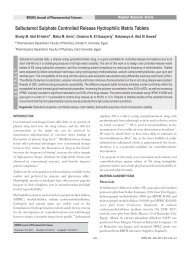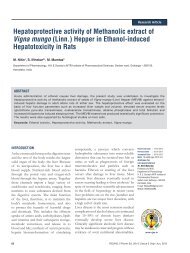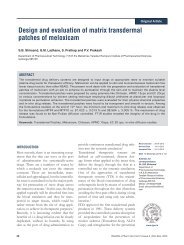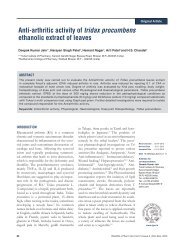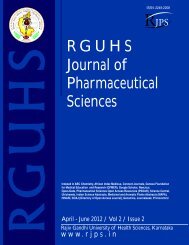Chitosan Loaded Mucoadhesive Microspheres of Gliclazide - Journal
Chitosan Loaded Mucoadhesive Microspheres of Gliclazide - Journal
Chitosan Loaded Mucoadhesive Microspheres of Gliclazide - Journal
You also want an ePaper? Increase the reach of your titles
YUMPU automatically turns print PDFs into web optimized ePapers that Google loves.
Figure 1. Creative thinking process<br />
Divergent<br />
customer service in a clinical or retail Pharma setting.<br />
One <strong>of</strong> the most difficult things in research as in any other<br />
endeavour is identifying a research question, a real problem<br />
(as opposed to a superficial or incorrect problem), or the cause<br />
<strong>of</strong> an organizational dilemma. Key is having in-depth<br />
knowledge related to the problem - <strong>of</strong>ten the salient issue<br />
arises from a knowledge-base developed in writing a review <strong>of</strong><br />
the relevant literature.<br />
Thus, how many have said they "invented" the latest new<br />
gadget or fad, only they never found the time to actually<br />
develop the product. They had the idea, but never took the<br />
idea to fruition. That's the difference between creativity and<br />
innovation.<br />
Elements <strong>of</strong> Creativity<br />
12<br />
Strong and Davis list four creativity elements; namely,<br />
valuable (perceived as having worth and genuinely contributing<br />
to society), intentional (result <strong>of</strong> a deliberate effort), novel (new or<br />
has at least some element <strong>of</strong> originality), excellent (significant<br />
effort expended to make it the best it can be). Thus, the<br />
creative product or service must be new and judged to be<br />
valuable according to designated criteria. Further, creative<br />
products are the result <strong>of</strong> purposive behaviour and to become<br />
13<br />
excellent, creative effort takes time . It is noted that creativity<br />
usually is not purely original, but rather that it stems from<br />
some prior knowledge and something is considered creative<br />
through implementation (innovation) and enhancement,<br />
although not necessarily a completely new idea. For example,<br />
the Romans improved upon Greek culture, and the Greeks in<br />
12<br />
turn built upon Mesopotamian and Egyptian cultures .<br />
Elements <strong>of</strong> Innovation<br />
A broadly accepted definition for innovation is: To turn a creative<br />
idea into products and services <strong>of</strong> value and pr<strong>of</strong>it. The basic goal <strong>of</strong><br />
all innovation is positive change, to make someone or<br />
something better. There are two basic types <strong>of</strong> innovation.<br />
Incremental Innovation: Also called continuous innovation, this<br />
Fredricka Reisman - Creative, Critical Thinking and Logic in Research<br />
Convergent<br />
Divergent Convergent Divergent Convergent<br />
type improves upon existing products/services. From a result<br />
standpoint, incremental innovations can range from very<br />
small to huge increases in productivity, revenues and pr<strong>of</strong>its.<br />
Breakthrough (Radical, Disruptive) Innovation: This type <strong>of</strong><br />
innovation develops new products/services that do not exist.<br />
Many times this type <strong>of</strong> innovation emerges from scientific<br />
discoveries or R&D organizations. But, while a breakthrough<br />
innovation might mean getting a patent, it does not guarantee<br />
huge pr<strong>of</strong>its.<br />
Out <strong>of</strong> many hundreds <strong>of</strong> creative ideas, only a few may ever<br />
be implemented. For those precious few, we know them as<br />
innovation - or simply, applied creativity.<br />
So creativity is the idea, and innovation is the idea applied or<br />
implemented.<br />
Future for Creative, Critical Thinking and Logic in<br />
India's Pharmaceutical Industries<br />
In September 2004, a global innovation survey by the<br />
14<br />
Economist Intelligence Unit identified India “as an R&D<br />
hotspot, defined as a place where (1) companies are able to tap<br />
into existing scientific and technical expertise networks, (2)<br />
there are good links to academic research facilities, (3) the<br />
environment supports innovation and (4) it is easy to<br />
commercialize.” The Economist further states:<br />
Costs <strong>of</strong> pharmaceutical innovation in India are estimated as low as oneseventh<br />
<strong>of</strong> their levels in Europe, and the country's clinical research<br />
industry is currently worth $100 million growing around 40 to 50<br />
percent annually, although some forecasts say it could be worth as much as<br />
$1 billion to Indian firms in 2008.<br />
The research enterprise in India is exemplified by numerous<br />
15<br />
R & D investments including the following :<br />
Ÿ AstraZeneca is conducting research into tuberculosis (TB) at the<br />
AstraZeneca Research Foundation India in Bengaluru. India's estimated<br />
8.5 million TB patients mean clinical trials can be conducted easily and<br />
economically.<br />
101 RJPS, Jul - Sep, 2011/ Vol 1/ Issue 2



